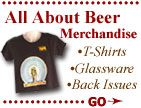
| ||||
| AAB Departments |
| ...Beer Features |
| ...Beer Talk |
| ...Pull Up A Stool! |
| ...What's Brewing |
| ...Beer Travelers |
| ...Stylistically Speaking |
| ...Beer & Food |
| ...Homebrewing |
| ...Collectibles |
| ...Marketplace |
| Beer Lovers' Resources |
| ...World Beer Festival |
| ...Brew Cruise Info |
| ...AAB Merchandise |
| ...AAB Bookstore |
| ...Beer Links |
| About the Magazine |
| ...Subscription Info |
| ...Retail the Magazine |
| ...Wholesaler Program |
| ...Advertising Info |
| ...Contact AAB |

|
All About Beer Magazine
Volume 23 Number 3
July 2002
Getting a Handle on Your Hobby
by Dave Gausepohl
 In the period after Prohibition, many taverns engaged in a classic bait-and-switch: They would advertise a particular brand of beer but serve a lower grade.
In the period after Prohibition, many taverns engaged in a classic bait-and-switch: They would advertise a particular brand of beer but serve a lower grade.
To stop this practice, many states passed laws calling for taverns to identify the beer being served on draft.
These new regulations created a need for tap markers--something to show what beer was being poured.
At first, the markers were purely functional: Known as "ball knobs," these early tap markers were made of chrome or Bakelite, an early type of plastic. About 2 to 3 inches tall, these markers all looked the same except for a round insert--usually of enamelled metal --that advertised the brand on one side.
But soon the breweries began to use these markers as a way to advertise their beers at the point of purchase. After World War II, more creative shapes and colors began to be used, some of them designed around the tapping breweries' system.
A Kooler Keg draft system, for example, did not have a threaded area to fasten the knob to. Instead it had a square peg that the knob was pressed onto. Some systems required an angled base to the knob so that it would not interfere with the faucet--this "sidewinder" style is highly collectible.
There also was a give-and-take between car and tap design. The early ball knobs quickly made their way to the gearshift handles of many cars. And, as our love for cars increased, many of the tap handles took on a look reminiscent of hood ornaments.
Once the importance of sports and beer advertising was discovered, the tap handles took the shape of bowling pins, baseball bats and baseballs, golf clubs and golf balls, cue sticks, footballs, hockey sticks, and basketballs. Tap handles also reflect the changing times, incorporating emblems of newer sports such as surfboards, NASCAR symbols and soccer balls.
 All kinds of materials and ingenious gimmicks have been used as well. Wooden, ceramics, composites, and plastics such as Lucite have made their way into icon at the barrelhead.
All kinds of materials and ingenious gimmicks have been used as well. Wooden, ceramics, composites, and plastics such as Lucite have made their way into icon at the barrelhead.
I have a Schmidt's of Philadelphia tap handle that emits a small radio frequency when it is moved forward. This radio signal is picked up by the receiver inside a lighted Schmidt's sign that flashes when the beer is poured.
And, as microbreweries have flourished across the country, so has the need for a distinctive tap handle. Many of the handles from the microbreweries help these little guys' beers stand out. As more and more of the multi-tap bars like The Flying Saucer, Old Chicago, The Beer Seller, Falling Rock Tap House and The Winking Lizard open across the United States, the need for a unique tap marker will remain. Let's face it: When you have 60-plus draft choices in front of you, sometimes the unique tap knob helps make your final choice.
----------------------------
Beer Dave Gausepohl has collected breweriana since 1974 and has a personal collection of over 400,000 items. He has visited over 1,000 breweries and tasted well over 10,000 different brews from the world over.








